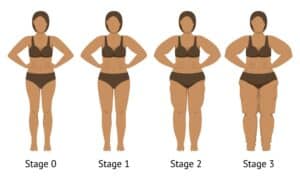Lipedema is a long-term condition that causes abnormal fat buildup. The buildup is present on both sides of the lower body. It most commonly impacts the buttocks, thighs, and calves. However, it can also impact the arms or hips in some cases. The condition makes daily life extremely difficult. Without treatment, many patients experience an overall lower quality of life. There is no cure for lipedema, but there are treatments that can effectively manage the condition. You may wonder, is lipedema genetic? We answer this question and share more information about the condition below.
Is Lipedema Genetic?
Lipedema is a chronic condition that impacts the lower half of your body in most cases. It can make walking difficult and cause pain. While there is no cure for the condition yet, lipedema treatment can dramatically improve the unwanted symptoms. There are several causes of the condition. One of the common causes is genetics. In fact, it is estimated to have a heritability rate of 50-60%. Those with a family member who has the condition are much more likely to develop it.
Common Causes of Lipedema
Genetics are a common cause of lipedema. However, it is not the only cause of the condition.
Hormonal Issues
Lipedema mostly impacts women. This demonstrates a strong link between lipedema and hormonal changes. The condition often develops or gets worse during puberty, pregnancy, and menopause. It can also occur or worsen when taking hormonal birth control. These periods often involve fluctuations in hormones, specifically estrogen and progesterone. Estrogen and progesterone are the hormones that regulate fat distribution.
Microvascular Dysfunction
Research has shown that microvascular dysfunction can cause lipedema. This is characterized by impaired blood and lymphatic vessel function. Patients often have weak capillaries and poor lymphatic drainage. The lymphatic system is responsible for removing excess fluids and waste. This leads to symptoms such as increased swelling and bruising. It also causes fat cells to enlarge. When left untreated, it can worsen and lead to lipedema.
Inflammation
As with so many health issues, inflammation can cause lipedema. Research suggests that chronic inflammation is a high-risk factor. When assessing patients with lipedema fat tissue, inflammatory markers were elevated. This can lead to so many unwanted symptoms. The most common include pain, swelling, and difficulty losing weight.
Preventative Measures to Lower Risk of Lipedema
While there is no foolproof way of preventing the condition entirely, there are helpful measures you can take. Consider the following ways to reduce your risk for the condition.
Maintain a Healthy Weight
Lipedema is not caused by obesity. However, more than half of patients with lipedema have a BMI over 35. Obesity is a huge risk factor for the condition. It can exacerbate the symptoms of lipedema and contribute to worsening fat accumulation. Maintaining your weight is necessary for your overall health and reducing your risk for chronic conditions like lipedema. Avoid yo-yo dieting and rapid weight fluctuations. Focus on consistency with your diet and exercise routine for the most effective results.
Regular Exercise
Exercise is essential for your overall health. It helps maintain your circulation, prevent fluid buildup, and support lymphatic drainage. These are all helpful in reducing your risk of lipedema. Aim for at least 150 minutes of moderate physical activity each week. Activities like walking, swimming, cycling, and Pilates are great options. Research has proven that consistent movement helps reduce fat accumulation and improve metabolic function. Maintaining a consistent exercise routine offers so many benefits to your health and overall quality of life.
Consume A Healthy Diet
Regular exercise is a great way to improve your health. However, it is important to couple that with a healthy and nutrient-rich diet. Your diet not only helps with weight management, but it can also manage inflammation and fluid retention. These are key factors in the development and exacerbation of lipedema. Focus on a diet that is rich in fruits, vegetables, lean proteins, healthy fats, and fiber. Avoid processed foods, excessive sugar, and refined carbohydrates. Whole foods that are rich in antioxidants and omega-3 fatty acids are helpful for metabolic health and weight management.
Prioritize Lymphatic Health
Your lymphatic system is critical when it comes to your overall health. It is a vital part of your immune function and maintaining fluid balance. It also removes waste, toxins, and other harmful substances from your body. Lipedema is linked to lymphatic dysfunction, so it is important to pay special attention to it. This includes staying hydrated, wearing compression garments, and engaging in light movement throughout the day. There are some less-researched yet potentially helpful strategies as well. This includes manual lymphatic drainage, dry brushing, and deep breathing exercises.
Treatment Options for Lipedema
There is no complete cure for lipedema. However, there are effective treatment options that can address the condition. Managing the symptoms through treatment can improve your overall quality of life. The condition has four unique stages, each with its own unique symptoms. The type of treatment that is right for you depends on the severity of your symptoms and the stage of the condition.

Stage 1
The first stage of lipedema includes mild pain and some bruising. The skin appears normal. However, you may be able to feel a pebbly texture underneath the skin. While conservative treatments can help during this stage, early liposuction from a skilled plastic surgeon is the most effective option. Combining liposuction with compression therapy, lymphatic drainage, dietary changes, and low-impact exercise are helpful.
Stage 2
The skin becomes more uneven with a pebbly texture. As time passes, fat accumulation increases. The signs of the condition are now visible and can cause increased pain. Combining all of the treatment options in stage 1 is necessary at this point. However, strength training is also recommended.
Stage 3
The visible symptoms of lipedema are pronounced in stage 3. The legs may look like balloons with folds. This symptom can cause a decline in mobility and make daily life very difficult. Pain and bruising also get worse. If the patient has not undergone liposuction by this point, they will usually find that it is the most effective method to address the unwanted symptoms. Combining liposuction with compression, low-impact exercise, and dietary changes is necessary.
Stage 4
The most difficult stage of the condition involves severe mobility impairment. Patients also experience extreme swelling, large skin folds, and pain. This can make daily life unbearable, and prompt treatment is necessary if nothing has been done yet. The best treatment options include advanced compression, liposuction, and lifestyle changes are critical.
Lipedema Treatment
If you struggle with lipedema and want treatment, contact the team at Gabbay Plastic Surgery today to schedule a consultation!




